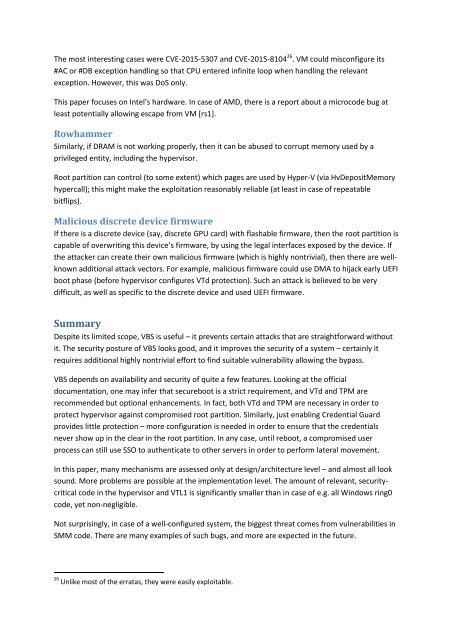WINDOWS 10 VIRTUALIZATION-BASED SECURITY
us-16-Wojtczuk-Analysis-Of-The-Attack-Surface-Of-Windows-10-Virtualization-Based-Security-wp
us-16-Wojtczuk-Analysis-Of-The-Attack-Surface-Of-Windows-10-Virtualization-Based-Security-wp
Create successful ePaper yourself
Turn your PDF publications into a flip-book with our unique Google optimized e-Paper software.
The most interesting cases were CVE-2015-5307 and CVE-2015-8<strong>10</strong>4 26 . VM could misconfigure its<br />
#AC or #DB exception handling so that CPU entered infinite loop when handling the relevant<br />
exception. However, this was DoS only.<br />
This paper focuses on Intel’s hardware. In case of AMD, there is a report about a microcode bug at<br />
least potentially allowing escape from VM [rs1].<br />
Rowhammer<br />
Similarly, if DRAM is not working properly, then it can be abused to corrupt memory used by a<br />
privileged entity, including the hypervisor.<br />
Root partition can control (to some extent) which pages are used by Hyper-V (via HvDepositMemory<br />
hypercall); this might make the exploitation reasonably reliable (at least in case of repeatable<br />
bitflips).<br />
Malicious discrete device firmware<br />
If there is a discrete device (say, discrete GPU card) with flashable firmware, then the root partition is<br />
capable of overwriting this device’s firmware, by using the legal interfaces exposed by the device. If<br />
the attacker can create their own malicious firmware (which is highly nontrivial), then there are wellknown<br />
additional attack vectors. For example, malicious firmware could use DMA to hijack early UEFI<br />
boot phase (before hypervisor configures VTd protection). Such an attack is believed to be very<br />
difficult, as well as specific to the discrete device and used UEFI firmware.<br />
Summary<br />
Despite its limited scope, VBS is useful – it prevents certain attacks that are straightforward without<br />
it. The security posture of VBS looks good, and it improves the security of a system – certainly it<br />
requires additional highly nontrivial effort to find suitable vulnerability allowing the bypass.<br />
VBS depends on availability and security of quite a few features. Looking at the official<br />
documentation, one may infer that secureboot is a strict requirement, and VTd and TPM are<br />
recommended but optional enhancements. In fact, both VTd and TPM are necessary in order to<br />
protect hypervisor against compromised root partition. Similarly, just enabling Credential Guard<br />
provides little protection – more configuration is needed in order to ensure that the credentials<br />
never show up in the clear in the root partition. In any case, until reboot, a compromised user<br />
process can still use SSO to authenticate to other servers in order to perform lateral movement.<br />
In this paper, many mechanisms are assessed only at design/architecture level – and almost all look<br />
sound. More problems are possible at the implementation level. The amount of relevant, securitycritical<br />
code in the hypervisor and VTL1 is significantly smaller than in case of e.g. all Windows ring0<br />
code, yet non-negligible.<br />
Not surprisingly, in case of a well-configured system, the biggest threat comes from vulnerabilities in<br />
SMM code. There are many examples of such bugs, and more are expected in the future.<br />
26 Unlike most of the erratas, they were easily exploitable.


